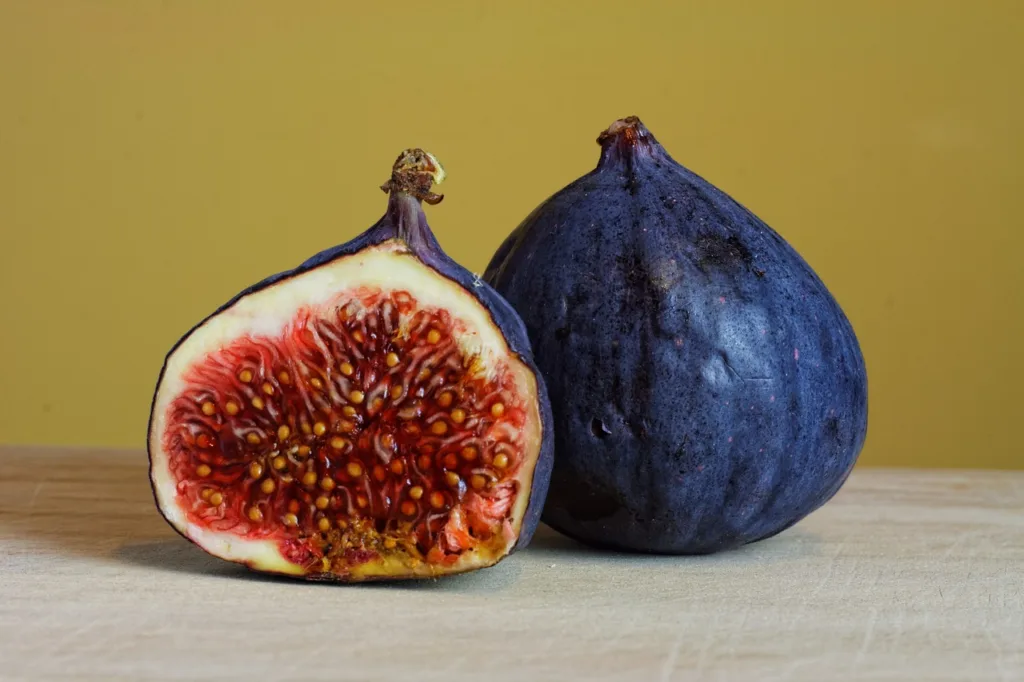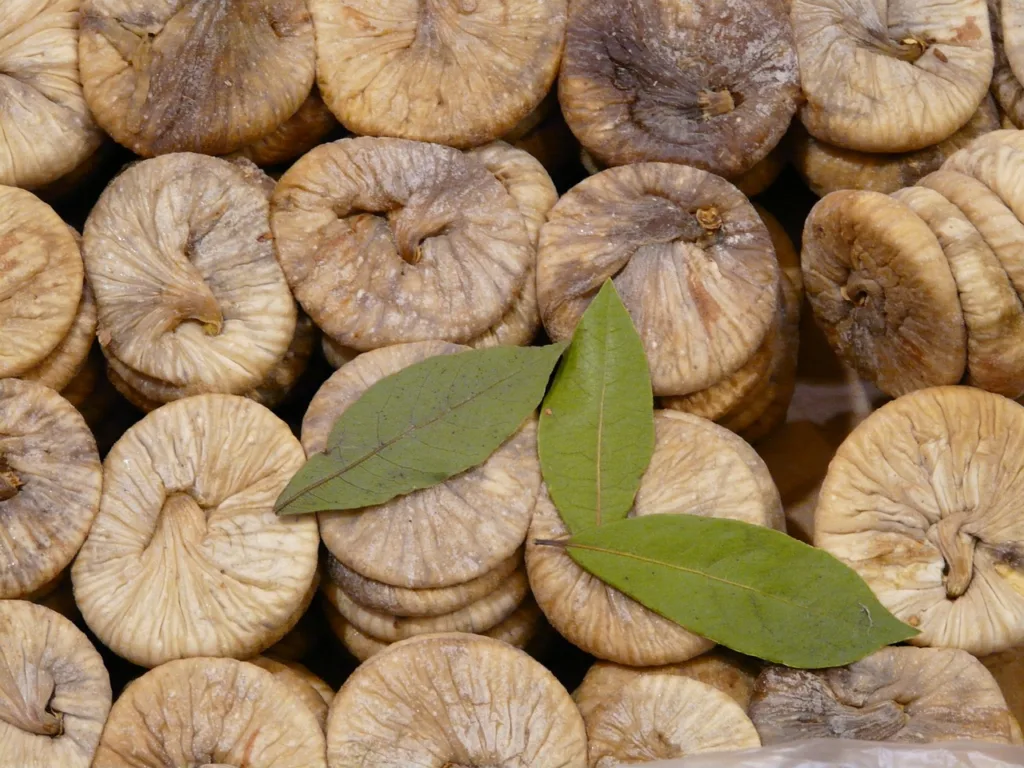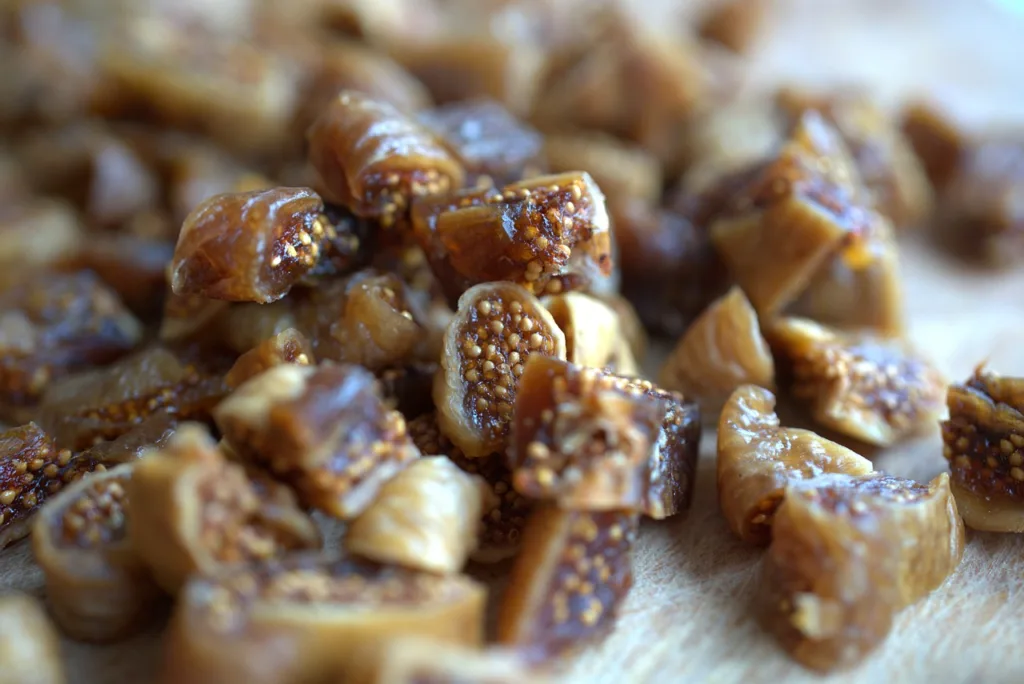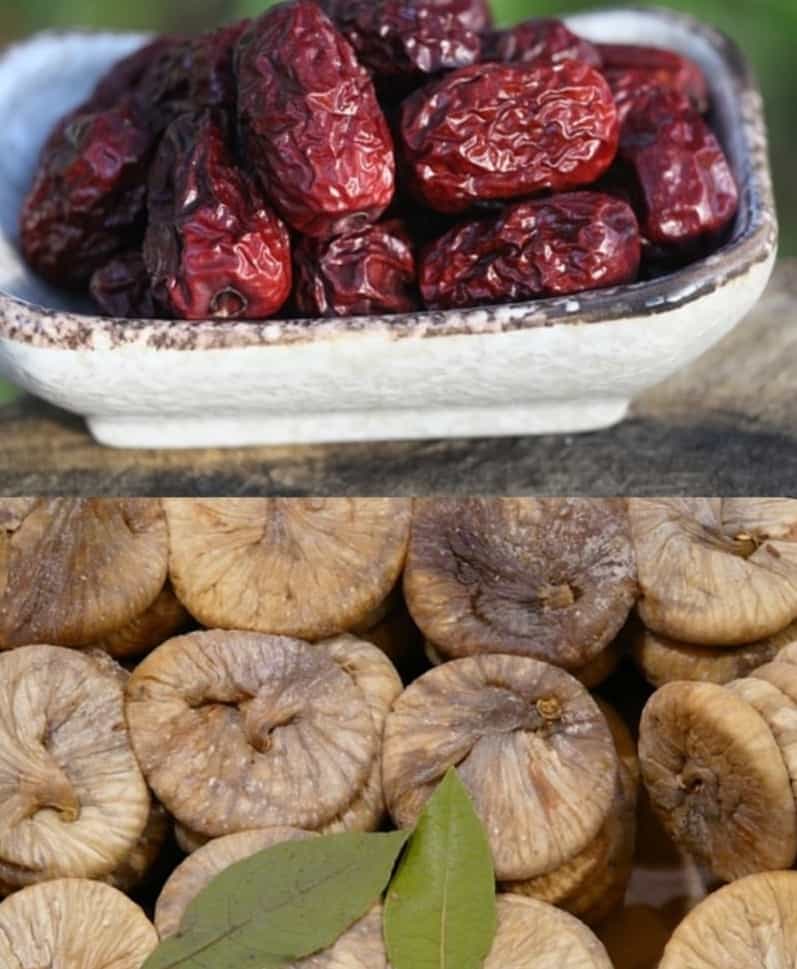
Fig is a fruit that grows on the fig tree (scientifically known as Ficus carica) Daffodil. The fig is unique in that it is actually an upside-down flower, with the flowers inside the fruit. These fruits have a soft, pear-shaped exterior and sweet and chewy pulp inside. Anjeer(fig) comes in a variety of colors, including green, yellow, purple, and black, depending on the variety.
The fig plant is a small deciduous tree or large shrub growing to 7–10 m (23–33 ft) tall with smooth white bark. Its large leaves have three to five deep parts. Its anjeer(fig) fruit (called a syconium, a type of multiple fruit) is teardrop-shaped, 3–5 cm (1–2 in) long, with green skin that ripens to purple or brown.
Figs can be eaten fresh or dried, or processed into jams, rolls, biscuits, and other types of sweets. Since the ripe fruit is not easily transported and well maintained, most commercial production is in dried and processed forms. Raw figs contain approximately 80% water and 20% carbohydrates, with negligible protein, fat, and micronutrients.
| Nutritional Component | Content per 100g of Raw Figs |
|---|---|
| Water | Approximately 79% |
| Carbohydrates | Approximately 19% |
| Protein | Approximately 1% |
| Fat | Negligible |
| Dietary Fiber | Approximately 14% of DV |
| Caloric Content | Approximately 310 kJ (74 kcal) |
| Micronutrients | Negligible |
Dried Figs
Dried figs have no natural habitat of their own as they are not a fruit that grows naturally in dried form. Dry Anjeer(fig) are actually fresh figs that have been dehydrated or dried in various ways to remove their moisture.
Once harvested, fresh figs are dehydrated to make the dried fruit that we commonly consume. Therefore, the habitat of dried figs is essentially the same as that of fresh figs, growing mainly in areas with Mediterranean and subtropical climates.
| Nutritional Component | Content per 100g of Dried Figs |
|---|---|
| Water Content (Dehydrated) | Approximately 30% |
| Carbohydrates | Approximately 64% |
| Protein | Approximately 3% |
| Fat | Approximately 1% |
| Dietary Fiber | Rich source (>20% DV) |
| Essential Mineral – Manganese | 26% DV |
| Other Micronutrients | Calcium, Iron, Magnesium, Potassium, and Vitamin K in moderate amounts |
| Caloric Content | Approximately 1,041 kJ (249 kcal) |

History
Dried Anjeer has a rich history dating back thousands of years. They originated in the Middle East and Mediterranean regions and were cultivated by ancient civilizations such as the Egyptians, Greeks, and Romans. Figs have cultural and religious significance, with references in the Bible and symbolism such as fertility and prosperity.
The common fig tree has been cultivated since ancient times and grows wild in dry and sunny places, in deep and fresh soils, and in rocky places.
Cultivation
The cultivation of dried figs involves the careful cultivation of fig trees, which are then used to produce dried figs by removing their moisture. The main steps include selecting the right fig tree variety for the chosen climate, providing suitable growing conditions with well-drained soil and proper spacing, and controlling factors such as watering, pruning, and fertilization to ensure the healthy growth of the trees. Management is involved.
Effective pest and disease management is important for the protection of fig trees, Harvesting organic ripe figs is a key moment in the process. Once harvested, the storing fresh figs are prepared for drying, which can be accomplished naturally by drying in the sun or by using a dehydrator. The drying process concentrates the flavor and preserves the fruit, allowing it to be stored for longer periods of time.
Overall, dried fig cultivation involves the nutrition of the fig trees and precise management of the drying process, resulting in a tasty and shelf-stable fruit.
How to Eat Dried Anjeer(figs)
Anjeer Dried fruit can be enjoyed in a variety of ways, making it an all-round and nutritious addition to your diet. These can be eaten as a standalone snack or mixed with nuts and cheese for a balanced meal. Dried figs can also be sprinkled on cereal or yogurt for added sweetness and texture.
On the other hand, we can be used in cooking and baking, dried figs can be added to dishes such as cakes, muffins, salads, and desserts to enhance flavor and moisture. They can be blended into smoothies for natural sweetness and fiber or filled with ingredients like cheese or nuts for an appetizer.
Are you a senior in your house and you have trouble chewing anjeer, but you have an option, soak 3, or 4 pieces of figs in warm water for an hour, after that, you can chew easily.
In addition, dried anjeer(figs) can be used to make chutneys. No matter how you want to enjoy them, dried figs offer a delightful combination of sweetness and chewiness that can elevate your culinary creations.
Benefits of Anjeer(Fig)
- Rich in Fiber: Dried figs are a high-fiber food, which can aid in digestive health by promoting regular bowel movements and preventing constipation. Fiber also helps with weight management and can contribute to a feeling of fullness.
- Nutrient-Dense: Dried figs are a concentrated source of essential nutrients, including vitamins (such as vitamin K and various B vitamins) and minerals (like calcium, potassium, magnesium, and iron). These nutrients support overall health and well-being.
- Antioxidant Properties: Dried figs contain antioxidants, which help protect the body from oxidative stress and free radical damage. Antioxidants play a role in reducing the risk of chronic diseases.
- Weight Management: Despite their natural sweetness, dried figs have a lower calorie content compared to many other sweet snacks. They can be a satisfying alternative for those looking to manage their weight.
- Heart Health: The fiber and potassium in dried figs can contribute to heart health. Fiber helps lower cholesterol levels, while potassium helps regulate blood pressure, reducing the risk of cardiovascular issues.
- Bone Health: Dried figs are a good source of calcium and vitamin K, which are important for bone health. Adequate calcium intake supports strong bones, while vitamin K is essential for bone mineralization.
- Natural Sugar: Dried figs contain natural sugars like fructose and glucose, providing a sweet taste without the need for added sugars. This can be a healthier option for satisfying sweet cravings.
- Energy Boost: The carbohydrates in dried figs provide a quick energy source, making them an excellent snack choice for an energy boost during physical activities or busy days.
- Iron Content: Dried figs contain iron, which is vital for red blood cell formation and oxygen transport in the body. This can help prevent iron deficiency anemia.
- Digestive Enzymes: Figs contain enzymes like ficin and bromelain, which aid in digestion by breaking down proteins and facilitating nutrient absorption.

Dried Figs During Pregnancy
Including dried figs in the diet of a pregnant woman can be beneficial. They provide a concentrated source of essential nutrients, including folate, iron, calcium, and magnesium, which are important for both maternal and fetal health.
The dietary fiber present in dried figs can help reduce digestive problems that often occur during pregnancy. Dried figs also provide a quick energy source, making them a convenient and nutritious snack option.
One to two dried figs can be a reasonable size to have as a snack or as part of a meal. It is essential to maintain a balanced diet during pregnancy, which includes a variety of fruits, vegetables, proteins, and whole grains. Dried figs can be a nutritious addition to this diet, but they should not replace other essential food groups.
Additionally, it is advisable to consult with a healthcare provider or registered dietitian who can provide personalized dietary recommendations based on your specific nutritional needs and any special considerations you may have during your pregnancy.
Drying figs in the oven
Ingredients and Equipment:
- Fresh figs
- Baking sheet or oven-safe tray
- Parchment paper or silicone baking mat
- Knife
- Optional: lemon juice (for preventing discoloration)
Instructions:
- Preheat the Oven:
- Preheat your oven to a low temperature, typically around 130°F to 140°F (55°C to 60°C). This low heat will gradually remove moisture from the figs while preserving their flavor and nutrients.
- Prepare the Figs:
- Wash and dry the fresh figs thoroughly.
- If desired, you can lightly brush each fig with lemon juice to help prevent discoloration during drying.
- Trim and Slice:
- Remove the stems from the figs and cut them in half or into slices. You can choose the size and shape that suits your preference.
- Arrange on Baking Sheet:
- Line a baking sheet or an oven-safe tray with parchment paper or a silicone baking mat. This prevents sticking and makes it easier to remove the dried figs later.
- Place the fig halves or slices on the baking sheet in a single layer, ensuring they are not touching or overlapping. This allows for even drying.
- Start Drying:
- Put the baking sheet with the figs into the preheated oven.
- Keep the oven door slightly ajar (you can use a wooden spoon to prop it open) to allow moisture to escape and facilitate drying.
- Monitor and Rotate:
- Check the figs periodically, approximately every 2-3 hours, and rotate the baking sheet if necessary to ensure even drying.
- Drying times can vary depending on the size and moisture content of the figs, but it usually takes anywhere from 8 to 12 hours.
- Test for Dryness:
- To check if the figs are sufficiently dried, remove one and let it cool to room temperature.
- When cooled, it should be slightly chewy and pliable, not moist or sticky. If it’s still moist, return it to the oven for further drying.
- Cool and Store:
- Once dried to your liking, remove the figs from the oven and let them cool completely on the baking sheet.
- Store the dried figs in an airtight container or resealable bags in a cool, dark place. They can stay good for several months.
Fig vs. Date: What’s the Difference
| Attribute | Figs | Dates |
|---|---|---|
| Fruit Type | Common fig (Ficus carica) | Date palm (Phoenix dactylifera) |
| Appearance | Varies in color, often purple or green skin with pink flesh | Oblong, cylindrical shape, brown to dark brown skin with sweet, caramel-like flesh |
| Taste | Sweet, honey-like flavor | Very sweet, caramel-like taste |
| Texture | Chewy with crunchy seeds | Soft and chewy |
| Nutritional Content | – Dietary Fiber – Vitamins (B vitamins) – Minerals (calcium, potassium, magnesium) – Antioxidants | – Dietary Fiber – Vitamins (particularly B vitamins) – Minerals (potassium, magnesium, iron) – Natural sugars (glucose and fructose) – Antioxidants |
| Calories | Moderate; approximately 47 calories per 100 grams | Moderately high; approximately 282 calories per 100 grams |
| Sugar Content | Naturally occurring sugars; no added sugars | High natural sugar content; primarily from fructose |
| Health Benefits | – Good source of dietary fiber, aiding in digestion – Provides essential minerals for bone health – Contains antioxidants that combat oxidative stress | – Excellent natural sweetener – High in dietary fiber for digestive health – Good source of potassium and magnesium – Provides quick energy due to sugar content |
| Common Uses | Eaten fresh, dried, or used in various recipes, including baked goods and salads | Consumed fresh or dried as a snack, and used in desserts, energy bars, and smoothies |
| Culinary Applications | Versatile in both savory and sweet dishes; pairs well with cheeses and meats | Predominantly used in sweet recipes, particularly Middle Eastern and North African desserts |
| Storage | Fresh figs should be stored in the refrigerator and consumed within a few days; dried figs have a longer shelf life and can be stored in a cool, dry place | Fresh dates should be stored in the refrigerator and consumed within a few weeks; dried dates are shelf-stable and can be stored at room temperature for an extended period |

People also ask
- Are dates good for you? Yes, dates are a nutritious fruit. They are a good source of dietary fiber, vitamins (especially B vitamins), and minerals like potassium, magnesium, and iron. Dates are also a natural sweetener, making them a healthier alternative to processed sugars.
- Are figs good for you? Yes, figs are also a nutritious fruit. They contain dietary fiber, vitamins (including B vitamins), and minerals like calcium, potassium, and magnesium. Figs are known for their natural sweetness and offer health benefits, particularly for digestion and bone health.
- Should I eat dates or figs? The choice depends on your taste preferences and dietary goals. Dates are sweeter and often used as natural sweeteners in recipes. Figs have a unique honey-like flavor and are versatile in both sweet and savory dishes. Incorporating both into your diet can provide a variety of nutrients.
- Is eating dried figs good for health? Yes, eating dried figs can be part of a healthy diet. They are a good source of dietary fiber, vitamins, and minerals. However, consume them in moderation due to their calorie content.
- Can I eat 2 dried figs a day? Yes, eating two dried figs a day is a reasonable portion size and can be part of a balanced diet. Just be mindful of your overall calorie intake and dietary goals.
- Can we eat anjeer fruit directly? Yes, you can eat fresh or dried figs (also known as anjeer) directly as a snack. They are delicious and nutritious on their own.

